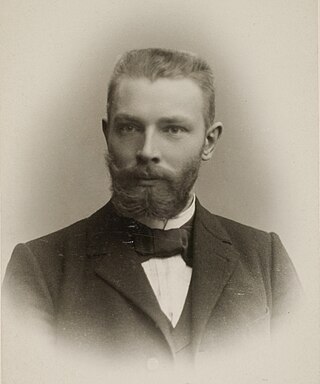
Finland, officially the Republic of Finland, is a Nordic country in Northern Europe. It borders Sweden to the northwest, Norway to the north, and Russia to the east, with the Gulf of Bothnia to the west and the Gulf of Finland to the south, opposite Estonia. Finland covers a total area of 338,145 square kilometres (130,559 sq mi), including a land area of 303,815 square kilometres (117,304 sq mi), and has a population of 5.6 million. Helsinki is the capital and largest city. The vast majority of the population are ethnic Finns. The official languages are Finnish and Swedish; 84.9 percent of the population speak the first as their mother tongue and 5.1 percent the latter. Finland's climate varies from humid continental in the south to boreal in the north. The land cover is predominantly boreal forest biome, with more than 180,000 recorded lakes.

The Finnish Civil War was a civil war in Finland in 1918 fought for the leadership and control of the country between White Finland and the Finnish Socialist Workers' Republic during the country's transition from a grand duchy ruled by the Russian Empire to a fully independent state. The clashes took place in the context of the national, political, and social turmoil caused by World War I in Europe. The war was fought between the Red Guards, led by a section of the Social Democratic Party, and the White Guards, conducted by the senate and those who opposed socialism with assistance late in the war by the German Imperial Army at the request of the Finnish civil government. The paramilitary Red Guards, which were composed of industrial and agrarian workers, controlled the cities and industrial centres of southern Finland. The paramilitary White Guards, which consisted of land owners and those in the middle and upper classes, controlled rural central and northern Finland, and were led by General C. G. E. Mannerheim.

Decapitation is the total separation of the head from the body. Such an injury is invariably fatal to humans and most other animals, since it deprives the brain of oxygenated blood by way of severing through the jugular vein and common carotid artery, while all other organs are deprived of the involuntary functions that are needed for the body to function. The term beheading refers to the act of deliberately decapitating a person, either as a means of murder or as an execution; it may be performed with an axe, sword, or knife, or by mechanical means such as a guillotine. An executioner who carries out executions by beheading is sometimes called a headsman. Accidental decapitation can be the result of an explosion, a car or industrial accident, improperly administered execution by hanging or other violent injury. The national laws of Saudi Arabia and Yemen permit beheading. Under Sharia, which exclusively applies to Muslims, beheading is also a legal punishment in Zamfara State, Nigeria. In practice, Saudi Arabia is the only country that continues to behead its offenders regularly as a punishment for capital crimes. Cases of decapitation by suicidal hanging, suicide by train decapitation and by guillotine are known.

Execution by firing squad, in the past sometimes called fusillading, is a method of capital punishment, particularly common in the military and in times of war. Some reasons for its use are that firearms are usually readily available and a gunshot to a vital organ, such as the brain or heart, most often will kill relatively quickly.

Suomenlinna, or Sveaborg, is a sea fortress composed of eight islands, of which six have been fortified; it is about 4 km southeast of the city center of Helsinki, the capital of Finland. Suomenlinna is popular with tourists and locals, who enjoy it as a picturesque picnic site. Originally named Sveaborg, or Viapori as referred to by Finnish-speaking Finns, it was renamed in Finnish to Suomenlinna in 1918 for patriotic and nationalistic reasons, though it is still known by its original name in Sweden and by Swedish-speaking Finns. Due to its strategic geographical location, it sometimes used to be known as Gibraltar of the North.

Karl Knutsson Bonde, also known as Charles VIII and called Charles I in Norwegian contexts, was King of Sweden and King of Norway (1449–1450).

The Red Terror was a campaign of political repression and executions in Soviet Russia carried out by the Bolsheviks, chiefly through the Cheka, the Bolshevik secret police. It officially started in early September 1918 and lasted until 1922. Arising after assassination attempts on Vladimir Lenin along with the successful assassinations of Petrograd Cheka leader Moisei Uritsky and party editor V. Volodarsky in alleged retaliation for Bolshevik mass repressions, the Red Terror was modeled on the Reign of Terror of the French Revolution, and sought to eliminate political dissent, opposition, and any other threat to Bolshevik power.

The Battle of Tampere was a 1918 Finnish Civil War battle, fought in Tampere, Finland from 15 March to 6 April between the Whites and the Reds. It is the most famous and the heaviest of all the Finnish Civil War battles. Today it is particularly remembered for its bloody aftermath as the Whites executed hundreds of capitulated Reds and took 11,000 prisoners who ended up in the Kalevankangas camp.

Capital punishment in Sweden was last used in 1910, though it remained a legal sentence for at least some crimes until 1973. It is now outlawed by the Swedish Constitution, which states that capital punishment, corporal punishment, and torture are strictly prohibited. At the time of the abolition of the death penalty in Sweden, the legal method of execution was beheading. It was one of the last states in Europe to abolish the death penalty.

Adolf Ivar Arwidsson was a Finnish political journalist, writer and historian. His writing was critical of Finland's status at the time as a Grand Duchy under the Russian Tsars. Its sharpness cost him his job as a lecturer at The Royal Academy of Turku and he had to emigrate to Sweden, where he continued his political activity. The Finnish national movement considered Arwidsson the mastermind of an independent Finland.

Perttula is a rural village along the Lopentie road in Nurmijärvi, Finland. Living is focused to agriculture. It's rounded neighboring villages like Uotila, Numlahti, Valkjärvi and Nummenpää. Nurmijärvi's largest village Klaukkala is located 8 kilometres (5.0 mi) southeast of Perttula.

Valter Thomé was a Finnish architect who worked in the National Romantic or Art nouveau style.

Finnish Civil War prison camps were operated by the White Finns to hold prisoners of war during and after the Finnish Civil War in 1918.

The Tammisaari camp was a concentration camp and prison in Dragsvik, Ekenäs in Finland. It was set for the Reds captured by the Whites in the 1918 Finnish Civil War. The concentration camp operated from May 1918 to 15 September 1918 when the majority of the captured Reds were released on parole. Tammisaari camp was then turned into a forced labour camp for convicted Reds and later in the early 1920s into a facility for political prisoners. Tammisaari camp was known as the most notorious of all Finnish Civil War prison camps. Between May and September 1918 nearly 3,000 of the 8,700 prisoners died of executions, disease or malnutrition.

The Viipuri massacre was the killing of approximately 360 to 420 Russians in the city of Viipuri during the Finnish Civil War in April–May 1918. The massacre took place during and after the Battle of Viipuri as the White Guards captured the city from the Red Guards. At least half of the victims were Russian soldiers and military personnel. The slain were mainly men and young boys: nine out of ten were men fit for military service. The White Guards were "cleansing" the city of Red Guards of whom 800 were slain; however, only a small minority of the killed Russians were affiliated with the Finnish labour movement.

All-female units of the paramilitary Red Guards served in the 1918 Finnish Civil War. The first Women's Guards units formed in early February in the main Finnish cities. More than 15 female Guards units were established by the end of March 1918, with a total of about 2,000 women serving. The female Guards units consisted of young industrial workers, maids, and servants. Their average age was about 20, but some were as young as 14. The women served in auxiliary units in combat.

The Battle of Länkipohja was a Finnish Civil War battle fought in the village of Länkipohja on 16 March 1918 between the Finnish Whites and the Finnish Reds. Together with the battles fought in Kuru, Ruovesi and Vilppula between 15 and 18 March, the Battle of Länkipohja was one of the first military operations related to the Battle of Tampere, which was the decisive battle of the Finnish Civil War. The battle is known for its bloody aftermath as the Whites executed 70–100 capitulated Reds. One of the executions was photographed and the images have become one of the best known pictures of the Finnish Civil War.
The Haaga executions of 1918 took place in Etelä-Haaga in what was then the Rural Municipality of Helsinge during the Battle of Helsinki of the Finnish Civil War on 12 April 1918. A total of 45 persons suspected of belonging to the Red Guards were executed by German troops at a bog at 8 o’clock p.m. at the site of the present Eliel Saarisen tie, halfway from the Pitäjänmäki roundabout to the tunnel leading to the Huopalahti Station, at the site of a pedestrian crossing. 28 of those executed were buried in the Pohjois-Haaga mass grave, which is located close to the current Pohjois-Haaga railway station.

Suomenlinna prison camp was a 1918 Civil War of Finland concentration camp in the Suomenlinna Fortress, Helsinki. It was established by the White Army for the Red Guard fighters taken prisoner after the Battle of Helsinki. The camp operated from April 1918 to March 1919. It was a subcamp for the Helsinki prison camp, which included the camps of Suomenlinna, Santahamina, Katajanokka and Isosaari.
The Tadamon massacre took place in the vicinity of Othman Mosque, Tadamon neighbourhood of the Syrian capital of Damascus, on 16 April 2013 during the Syrian civil war. Soldiers affiliated with the Syrian Armed Forces, specifically Branch 227 of the Military Intelligence Directorate, killed at least 41 civilians, and is suspected to be up to 288 people who were taken to one of the isolated neighborhoods of Damascus and executed one after the other in a mass grave that had been prepared in advance.

















